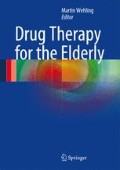Abstract
Maintaining postural stability in the supine position is a complex task and therefore vulnerable to disturbance by a variety of factors that may cause loss of stability and result in falls. In the elderly, as opposed to younger patients, a fall from standing or a fall while walking at low speed may end up in clinically significant incidents, namely, fractures. Typical falls in the elderly have to be distinguished from syncope, which describes a short-time loss of consciousness of sudden onset. In every fall incident, a syncope has to be ruled out as its management requires different diagnostic and therapeutic algorithms aiming at underlying cardiac diseases. Syncopes may also be provoked by drug therapy due to bradycardia, torsades, or orthostatic hypotension. In the following, we focus on typical falls in the elderly.
Access this chapter
Tax calculation will be finalised at checkout
Purchases are for personal use only
References
Annweiler C, Montero-Odasso M, Schott AM, Berrut G, Fantino B, Beauchet O (2010) Fall prevention and vitamin D in the elderly: an overview of the key role of the non-bone effects. J Neuroeng Rehab 7:50–63
Bischoff-Ferrari HA, Dawson-Hughes B, Staehelin HB, Orav JE, Stuck AE, Theiler R, Wong JB, Egli A, Kiel DP, Henschkowski J (2009) Fall prevention with supplemental and active forms of vitamin D: a meta-analysis of randomised controlled trials. BMJ 339:b3692
Blain H, Blain A, Trechot P, Jeandel C (2000) Role des medicaments dans les chutes des sujets ages. Presse Med 29:673–680
Campbell AJ (1991) Drug treatment as a cause of falls in old age. Drugs Aging 1:289–302
Chang JT, Morton SC, Rubenstein LZ et al (2004) Interventions for the prevention of falls in older adults: systematic review and meta-analysis of randomised clinical trials. BMJ 328(7441):680–687
Chapuy MC, Arlot ME, Duboeuf F et al (1992) Vitamin D and calcium to prevent hip fractures in elderly women. N Engl J Med 327:1637–1642
U.S. Congress, Office of Technology Assessment (1994) Hip fracture outcomes in people 50 and over—background paper, OTA-BP-H120, U.S. Government Printing Office, Washington, DC
Cumming RG (1998) Epidemiology of medication-related falls and fractures in the elderly. Drugs Aging 12:43–53
French DD, Campbell R, Spehar A, Cunningham F, Bulat T, Luther SL (2006) Drugs and falls in community-dwelling older people: a national veterans study. Clin Ther 28(4):619–630
Gupta V, Lipsitz LA (2007) Orthostatic hypotension in the elderly. Am J Med 120:841–847
Haddad PM, Sharma SG (2007) Adverse effects of atypical antipsychotics: differential risk and clinical implications. CNS Drugs 21(11):911–936
Kenny AM, Boxer RS, Kleppinger A, Brindisi J, Feinn R, Burleson JA (2010a) Dehydroepiandrosterone combined with exercise improves muscle strength and physical function in frail older women. J Am Geriatr Soc 58:1707–1714
Kenny AM, Kleppinger A, Annis K, Rathier M, Browner B, Judge JO, McGee D (2010b) Effects of transdermal testosterone on bone and muscle in older men with low bioavailable testosterone levels, low bone mass, and physical frailty. J Am Geriatr Soc 58:1134–1143
Kron M, Loy S, Sturm E, Nikolaus T, Becker C (2003) Risk indicators for falls in institutionalized frail elderly. Am J Epidemiol 158:645–653
Leipzig RM (1998) Avoiding adverse drug effects in elderly patients. Cleve Clin J Med 65:479–485
Leipzig RM, Cumming RG, Tinetti ME (1999) Drugs and falls in older people: a systematic review and meta-analysis: I. Psychotropic drugs. J Am Geriatr Soc 47:30–39
Mohr BA, Bhasin S, Kupelian V et al (2007) Testosterone, sex hormone-binding globulin, and frailty in older men. J Am Geriatr Soc 55:548–555
Pfeifer M, Begerow B, Minne HW, Suppan K, Fahrleitner-Pammer A, Dobnig H (2009) Effects of a long-term vitamin D and calcium supplementation on falls and parameters of muscle function in community-dwelling older individuals. Osteoporos Int 20:315–322
Räihä I, Luutonen S, Piha J, Seppanen A, Toikka T, Sourander L (1995) Prevalence, predisposing factors, and prognostic importance of postural hypotension. Arch Intern Med 155:930–935
Sleeper R, Bond CA, Rojas-Fernandez C (2000) Psychotropic drugs and falls: new evidence pertaining to serotonin reuptake inhibitors. Pharmacotherapy 20:308–317
Souchet E, Lapeyre-Mestre M, Montastruc JL (2005) Drug related falls: a study in the French Pharmacovigilance database. Pharmacoepidemiol Drug Saf 14:11–16
Stel VS, Smit JH, Pluijm SMF, Lips P (2004) Consequences of falling in older men and women and risk factors for health service use and functional decline. Age Ageing 33:58–65
Tamblyn R, Abrahamowicz M, du Berger R, McLeod P, Bartlett G (2005) A 5-year prospective assessment of the risk associated with individual benzodiazepines and doses in new elderly users. J Am Geriatr Soc 53:233–241
Tinetti ME, Speechley M, Ginger SF (1988) Risk factors for falls among elderly persons living in the community. N Engl J Med 319:1701–1707
Van der Velde N, Stricker BH, Pols HA, Van der Cammen TJM (2006) Risk of falls after withdrawal of fall-risk-increasing drugs: a prospective cohort study. Br J Clin Pharmacol 63:232–237
Woolcott JC, Richardson KJ, Wiens MO et al (2009) Meta-analysis of the impact of 9 medication classes on falls in elderly persons. Arch Intern Med 169:1952–1960
Author information
Authors and Affiliations
Corresponding author
Editor information
Editors and Affiliations
Rights and permissions
Copyright information
© 2013 Springer-Verlag Wien
About this chapter
Cite this chapter
Burkhardt, H. (2013). Fall Risk and Pharmacotherapy. In: Wehling, M. (eds) Drug Therapy for the Elderly. Springer, Vienna. https://doi.org/10.1007/978-3-7091-0912-0_19
Download citation
DOI: https://doi.org/10.1007/978-3-7091-0912-0_19
Published:
Publisher Name: Springer, Vienna
Print ISBN: 978-3-7091-0911-3
Online ISBN: 978-3-7091-0912-0
eBook Packages: MedicineMedicine (R0)

